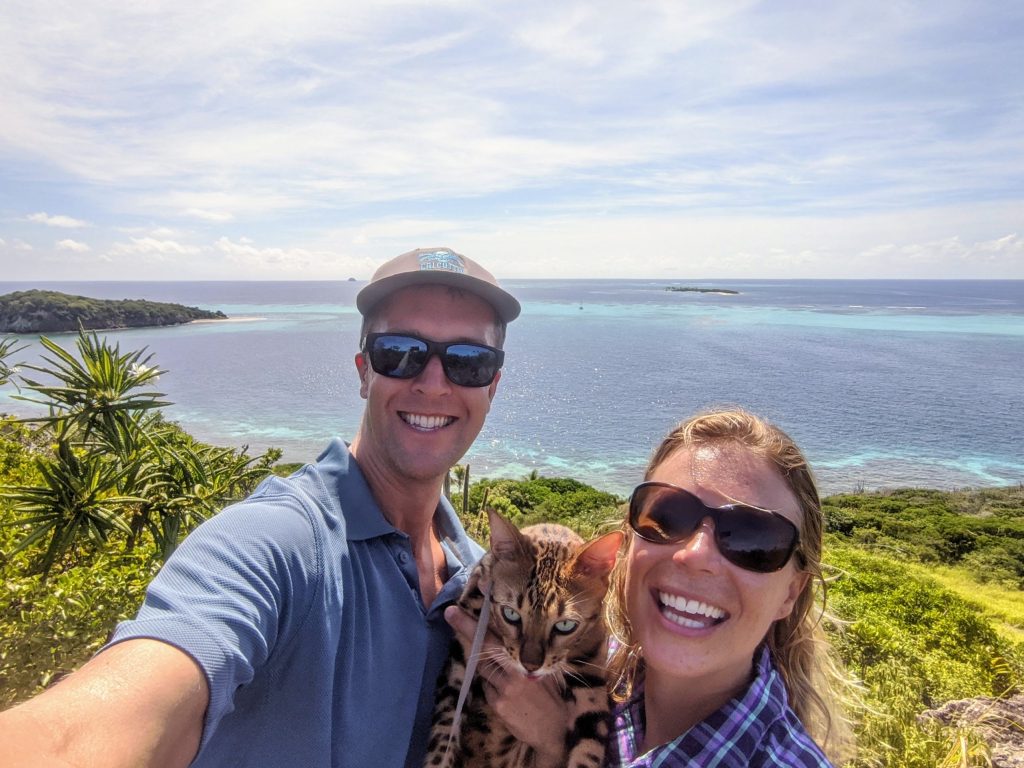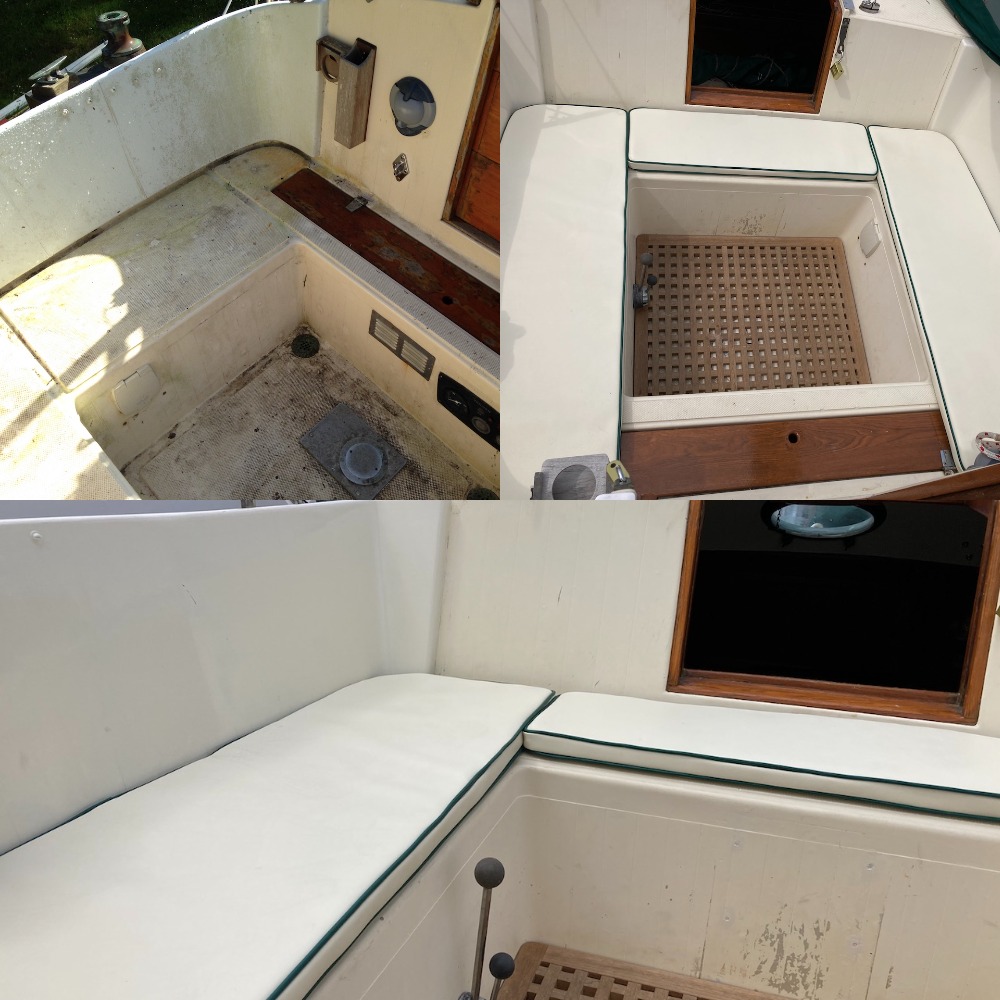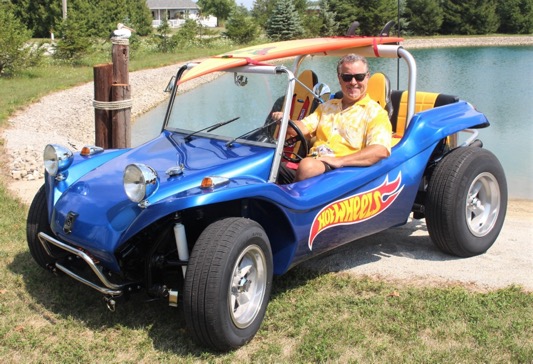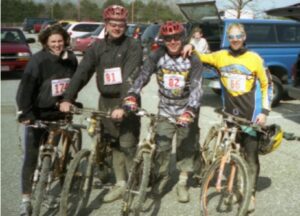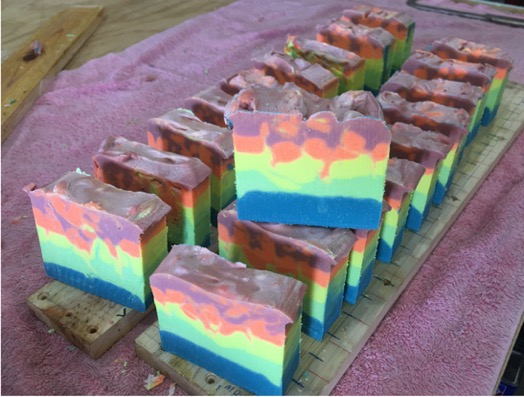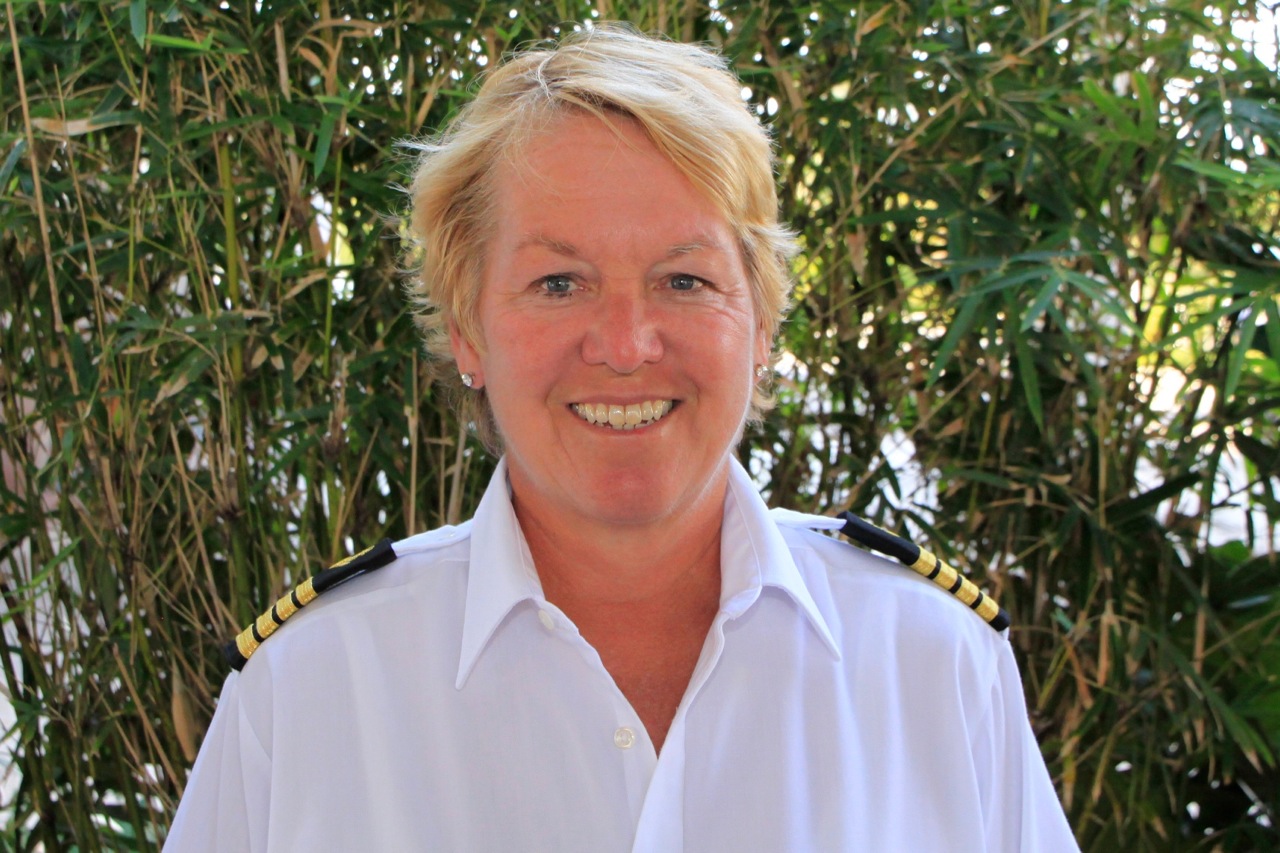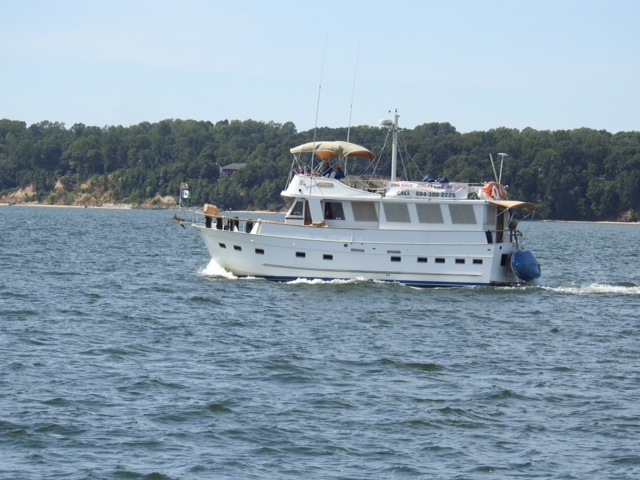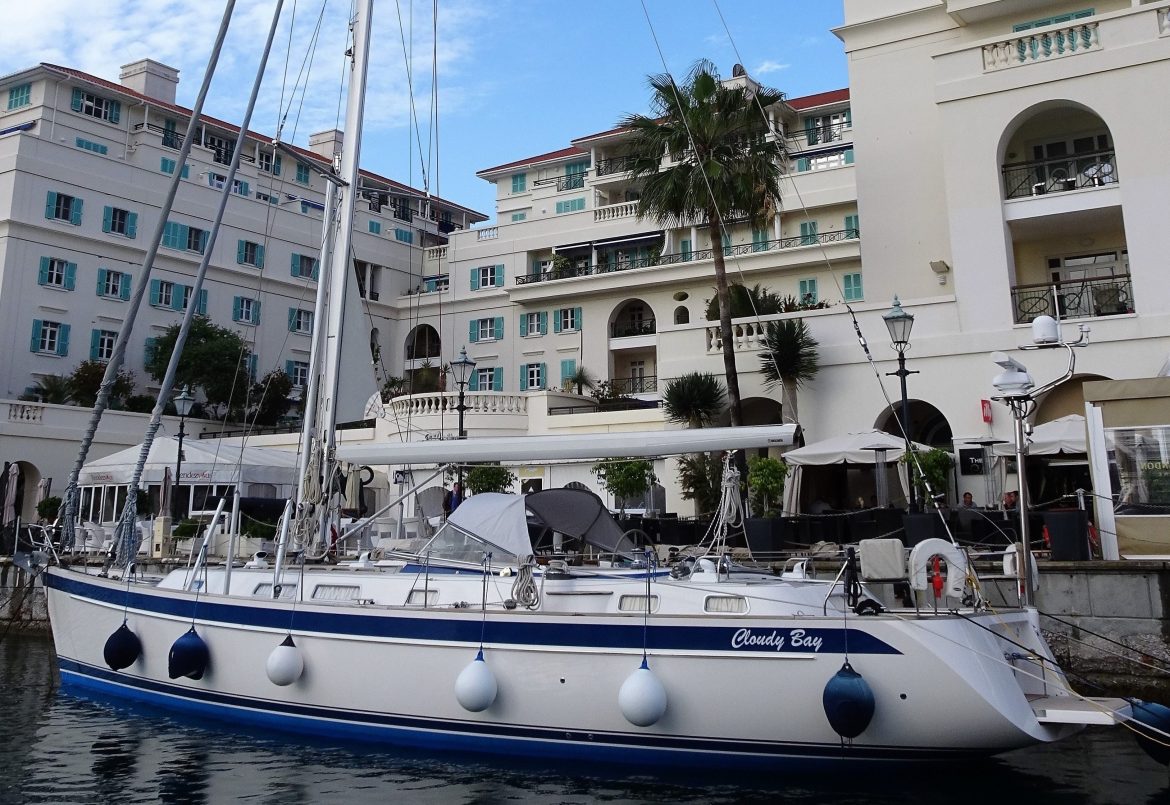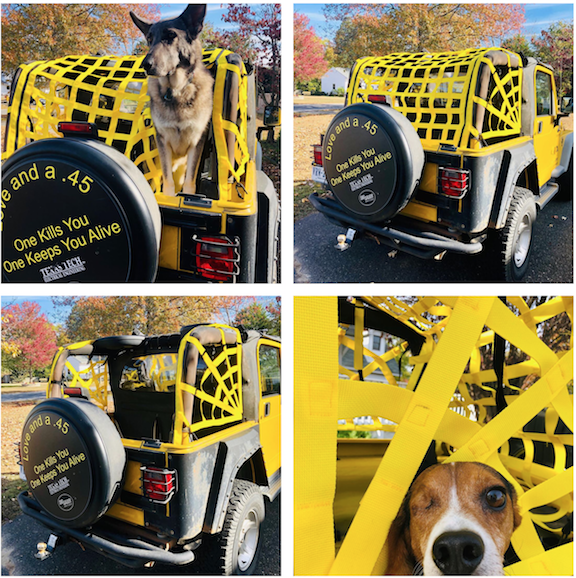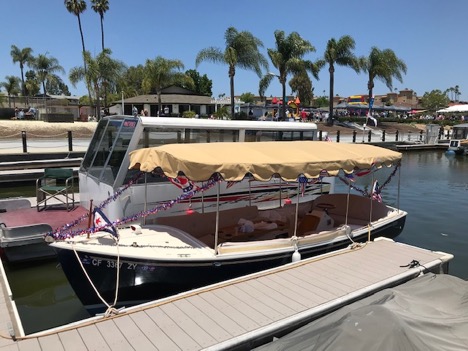What do you do when a global pandemic halts your international travel plans and you’re forced to remain stateside? You tackle the sewing project of your DIY career, of course! That’s exactly what Lynn Ringseis did. She spent summer 2020 on a friend’s Westsail 42-foot sailboat in Poulsbo, Washington, riding out the COVID-19 quarantine. Not one to let a change of plans damper her spirit, Lynn offered to tackle several sewing projects for her friend, one of which was designing and sewing a full enclosure for the cockpit attached to the hardtop bimini. Learn how she conquered this difficult project using a borrowed Ultrafeed® LSZ Sewing Machine and Sailrite supplies and free video content.
2020 was supposed to be a fresh start for Lynn. When her captain and husband, John, passed away, she decided that she needed a change of scenery and a new adventure. She found renters for her house and planned a global expedition, visiting the vast network of worldwide nautical friends she and John had made over the years. Lynn has spent most of her adult life traveling the world, working on sailboats, and discovering a passion for ocean conservancy and wildlife protection.
It was March 12, 2020, and Lynn was just hours away from boarding her flight from San Francisco to Fiji. “As the pandemic news grew more alarming, I pulled the plug on my trip as I didn’t want to take any chances of unwittingly spreading a virus to my dear Fijian friends. Time for a pandemic pivot.” Having already rented her house, Lynn needed a place to stay. Luckily, a fellow sailing friend asked her to “boat sit” for him for the summer and she happily accepted.

On the water is Lynn’s favorite place to be, so she didn’t see the temporary delay in her travel plans as too much of an inconvenience. The marina had every amenity she could need — laundry, showers, a grocery store and carry out dining. “It wasn’t exactly the tropical waters I had planned, but I became enamored with the wildlife and the beauty of the Pacific Northwest.”
She arrived in Washington eager to help out her friend, Christian — who was away most of the summer working as an aerial firefighter — and tackle some needed boat projects, the first of which was the daunting cockpit enclosure. The wet, temperate climate of the Pacific Northwest meant Lynn was in desperate need of a dry cockpit to ride out her stay. Lynn had never attempted such a complicated project, so she first checked local canvas shops to commission a cockpit enclosure. All of the shops were booked for months out.
Luckily, Christian is a Sailrite customer and had an Ultrafeed LSZ on board. With time on her hands and an Ultrafeed at her disposal, Lynn set out to tackle the project herself. “This was by far my largest and most complicated sewing project, with unusual angles, curves and geometry to figure out. But, to me, that was more fun than straight lines! I pushed myself to accomplish something beyond what I perceived as my ability. I sourced materials through Sailrite and began receiving shipments at the marina.”
Keep reading to learn more about Lynn, her sailing career and how she conquered her list of quarantine projects.

Q. Do you have a sailboat currently?
A. Currently, I do not own a sailboat, but I am a fortunate member of the OPB (Other People’s Boats) Yacht Club! I do enjoy puttering with friends on my Duffy electric boat. She is named “Bootlegger” and she acts as our speakeasy with her quiet, electric engine.
Captain John and I owned a Catalina 30 that we cruised in Mexico in the early 1990s. She was a sweet and relatively simple boat and didn’t require major projects. We cruised from the Sea of Cortez as far south as Acapulco and gunkholed everywhere in between. We then got a job working on crewed sailing yachts in the Eastern Caribbean.
Over many years, we hosted guests on Beneteau sailboats, Jeanneau yachts and a brand-new Leopard 45 catamaran. We loved working on and sailing the catamaran so much that we decided to buy a Lagoon 41. We commissioned her in the fall of 2003, named her “Moonshine,” and sailed across the Atlantic to the French West Indies and eventually to the British Virgin Islands to start our own charter operation.
Q. When did you learn how to sail and who taught you?
A. I was living and working in Africa with my then boyfriend, Tom, in 1984, and our French friends offered us a crewing position to cross the Atlantic to Martinique. We met our French Captain Daniel in Marseille, France, that fall. My only prior sailing experience was on Mission Bay, San Diego, on little Sabots. Neither of us spoke French, but that didn’t stop us from jumping on this adventure!
We met our ride, a 33-foot Gibsea and our assortment of crewmates: a fellow hitchhiker from the U.S. and three French crew who spoke little English. Our language barrier helped us all get along tremendously. At the dinner table, we would all talk about each other and laugh as no one understood anything! I tried very hard to learn about sailing from Captain Daniel, as he was a superb skipper.
This was long before GPS, and Daniel would shoot the sun and stars with a sextant. I was fascinated, especially when we pulled into Fort-de-France, Martinique, after 24 days, spot on from the Cape Verde islands, situated at the westernmost point of the African continent. I was hooked on sailing!

Q. What do you love about sailing?
A. I have a lifelong passion for being on the ocean. Being a San Diego native, I would visit the beach at every opportunity. Sailboats bring you closer and quieter to the environment that I love. I enjoy the challenge of sailing and there is no sweeter place to be than on a beam reach with soft, tropical trade winds kissing your sails as you scour the sea for whales and wildlife. One of the most invigorating things for me is to arrive at a new port after being at sea on a long journey as all your senses come alive at navigating toward land and an unfamiliar harbor or anchorage.
Q. Can you describe the various canvas projects you completed when quarantined on your friend’s boat in summer 2020?
A. The full enclosure started with installing two parallel Flex-A-Rail awning tracks on the ceiling of the hardtop, as I wanted sliding doors for ease of entry. I used a heat gun to shape the track to fit the vertical curves on the outside as an anchor for the first panels. I used Dura-Skrim® Patterning Material and cut and taped each panel. My measuring tape became my constant companion.
This was the first time I had worked with awning track and Keder awning rope products. I integrated Phifertex® into the top of the aft panels for ventilation. Working with O’Sea 40 gauge window material was easier than I expected. I marked the outline with a yellow grease marking pencil. Cutting and sewing to Sunbrella® was a breeze, especially with the help of Seamstick basting tape. I chose Cadet Grey V-92 Bonded Polyester 4 oz. Thread, and my color choice of Sunbrella Marine Grade fabric is officially named Basil, but I called it “Margarita,” as it just sounded more fun!
I referenced several of Sailrite’s how-to videos to help me with the boat projects. I watched videos on how to make winch covers, how to bend and install Flex-A-Rail and how to make an aft curtain. Many thanks for the great videos and support from the Sailrite team!
I continued to craft unusual projects for the boat, such as fender holders I fashioned from Sunbrella and Phifertex, which I designed to go over the aft railing like saddlebags. The bags held the fenders on the outside with an inner bag for lines and other equipment.
Q. Was sewing these projects for your friend’s boat the first time you used the Ultrafeed LSZ Sewing Machine? What are your impressions of the machine after using it for a handful of projects?
A. Yes, it was my first time getting acquainted with the LSZ. I think of her as the Jeep of sewing machines and super tough. I got to know her most intimately. With the detailed instructions Sailrite provides, I was able to make all necessary adjustments and the ease of accessing the machine for applying oil was remarkable. She is a well-built, sturdy tool.
The Ultrafeed LSZ sure kept me company while I was on the boat for months. I named her Tiburón, for my love of sharks. She and I spent a lot of time together.
Q. Since the full boat enclosure for your friend, have you sewed any other big projects that challenged your sewing skills?
A. The next project I tackled was side panels and windows for my little Duffy electric 18-foot boat in California. I was there for a quick trip and took lots of photos and measurements and proceeded to tackle that project back onboard in Poulsbo. Mind you, I had the machine set up on the Sailrite Ultrafeed Collapsible Table in the lower salon area, which measures 5 feet by 8 feet. Working in a relatively small space was all part of the fun challenge! I chose Sunbrella Marine Grade in Aruba. When I got back to California, I installed the windows and they fit like a charm, but they make the surrey top look a little sad. I just may be learning how to make a surrey top next!

Q. Can you tell us what’s next for your DIY sewing adventures?
A. During quarantine, I became acquainted with some of the livaboards at the marina, which reminds me of one of my favorite quotes: “A tourist remains an outsider throughout his visit; but a sailor is part of the local scene from the moment he arrives.” (Anne Davison) The sailing community has always felt like my “tribe.”
After seeing the enclosure, one of my sailboat neighbors at the marina asked me to create some mesh shade screens for his side windows. I used Phifertex Plus vinyl mesh, Sunbrella frames and Stamoid™ bias binding tape to finish the edges. I still feel new enough not to charge money, so we are making a swap for some of his expert woodworking skills in the galley. The pandemic may have been the catalyst for my newfound “Covid Career.”
Q. Is there anything else you’d like our readers to know about you, your love of sailing or your DIY lifestyle?
A. The cockpit has been transformed into a protected sunroom or, as I like to call it, the lanai — almost as warm as Fiji.
I also have been through a transformation of life, blessed to find seafaring mates to continue living a nautical journey. You may be wondering, how did my client, Christian, like my custom cockpit enclosure? Well, the enclosure received an enthusiastic two thumbs up. I am still onboard, and we are planning voyages, adventures and ocean environmental projects. Perhaps I’ll get my trip to Fiji after all, this time on a gorgeous sailboat! A happy ending to my sewing story.
My deep devotion to the sea prompted me to volunteer for Sea Shepherd Conservation Society, a nonprofit marine conservation organization, aboard one of their vessels. I spent three months crewing on their former Coast Guard Cutter named “MV John Paul Dejoria,” engaging in several campaigns in the Sea of Cortez to Peru, with a brief stop in the Galapagos Islands. Christian shares the same passion and he has also served aboard Sea Shepherd vessels.
Sea Shepherd’s mission is to partner with governments around the world to assist them with the detection and capture of criminal enterprises that are engaged in illegal, unreported and unregulated fishing operations.

Thank you so much for sharing your story with us, Lynn. We’re thrilled that Sailrite could be part of your DIY journey. Good luck with your future travels, and we hope you make it to Fiji soon!
If you’d like to tag along with Lynn on her oceanic adventures and other travels, you can follow her personal blog: www.bootleggerbay.com.
Who We Are
Sailrite is your one-stop DIY shop! We are a passionate crew of do-it-yourselfers who strive to equip you with the supplies and how-to knowledge you need to tackle your next project. Do you want to learn upholstery, leatherwork, canvaswork, hobby sewing, bag making or more? We have the fabric, tools, hardware, sewing machines and notions you need to master any DIY. And even if you’ve never sewn before, our tutorials and how-to videos are designed for beginners and experienced crafters alike.
Start your DIY journey today: www.sailrite.com









